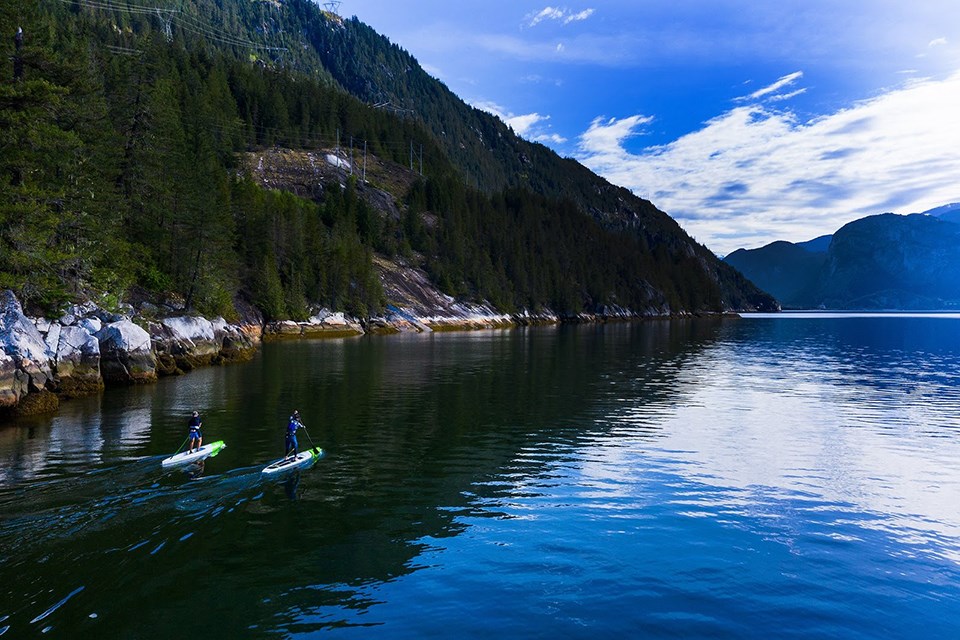Paddle sports in the Squamish area are growing in popularity. With a vast array of outdoor activities on offer, it might seem that getting on the water should have taken off among the crowds earlier, about the time hikers, mountain bikers and climbers were turning Squamish into the outdoor capital it has become.
But a misperception prevailed, making watersports on Howe Sound less popular than they deserve to be, according to Philip Kaiser, treasurer of the Squamish Paddling Club. His group has tried to counter the idea that paddling on Howe Sound is for elite-level paddlers only.
“In part, we created that problem by hosting a massive downwind race from Porteau Cove to Squamish with most of the top surf ski paddlers in the world in it,” he says. “That perhaps assisted in perpetuating that belief.”
While Kaiser is emphatic that anyone going out of the water needs to treat it with proper respect, start with professional guidance and take nothing for granted, he also wants to dispel the fun-inhibiting idea that newbies should avoid it.
“The key thing is getting proper training and proper education,” he says, adding that proper safety equipment and progressive skill building are crucial. Likewise vital is choosing the right time. Ocean paddling in this area is an early morning activity because prevailing winds kick up mid- to late-morning, making it unpleasant if not dangerous.
“We encourage people to paddle in the morning because, if you try in the afternoon, you are going to get pummeled and it does become a more advanced, experienced paddlers realm,” says Kaiser. “The key message really is just being aware of what the local conditions are, what the safety equipment is and getting yourself trained and educated on when it's best to paddle for your abilities.”
Mid-morning is when the kiteboarders come out, exploiting the region’s world-class windscape for midday fun. The Squamish Spit has been ground zero for kiteboarding in recent years, including the renowned Kite Clash – Canada’s largest such annual event — though that is off this year due to COVID-10.
While all paddle sports have taken off in popularity, stand up paddleboarding has seized the trendiness quotient. A style that began in Hawaii just a couple of decades ago has taken the West Coast by storm.
“Stand up paddleboarding, at the end of the day, is nothing but a canoeing stroke,” Kaiser says. Put simply, there are two types of paddle sports: canoe strokes, using a single paddle, and kayak paddling, using a double-ended paddle. SUP – stand up paddleboarding – attracts people who just want to get on the water and aren’t into competition and maybe don’t care about perfecting technique.
“It's great, it's wonderful,” says Kaiser. But he also warns that the stability of the stand up paddleboard and the ease of getting back on it if you fall off – the very things that make it ideal for entry-level paddlers – can also give people a false sense of security.
“They almost feel indestructible,” he says. “It's so easy to start, that can end up being its demise because people end up being too confident.”
The Squamish Paddling Club has programs to get families on the water, though river paddling isn’t one of their offerings right now, mostly because the programs they offer reflect the interests of their members who volunteer to lead programs.
There used to be a white water club in town, but it folded. Most river paddlers have their own groups they practice and paddle with. But Squamish is not an ideal entry-level river paddling area.
“We have more technically challenging white water and, at that level, you do need to have more skills and you really do need to rely on the people you're paddling with,” he says.
While the Squamish Paddling Club and the Squamish Windsport Society bring experienced folks and newcomers together, there are professional guides, trainers and tour leaders available in town for almost every outdoor activity.
Norm Hann Expeditions exists, says the eponymous owner, to get people out on the water. Stand up paddleboarding is his most popular offering. He’s got a two-hour program he bills as an intro to Howe Sound and the half-day Fjord Explorer.
“The Fjord Explorer is going to give us the opportunity to really explore much more of Howe Sound and work down the shoreline to Woodfibre, which is a really spectacular shoreline,” says Hann. “It also gives us time to explore the estuary a little bit more as well.”
One of the reasons for the increased popularity of paddling is the revival of the Howe Sound ecosystem.
“It's been absolutely incredible the last, I would say, four, five years,” says Hann. “I've been out there paddling for maybe 12 years now and just the change of wildlife I see coming back as Howe Sound has started to clean up over the last number of years has been miraculous really.”
Herring populations, crucial to the entire ecosystem, have rebounded recently, resulting in concentric circles of wildlife.
“We're getting really big numbers of steller sea lions,” he says, as well as seals, river otters, eagles, mergansers and, on a really good day, orcas.
While inexperienced paddlers should seek out qualified teachers, equipment is available for rent at several locations in Squamish for those with appropriate skill levels. There are also plenty of options to build skills on local lakes before taking on the ocean.



